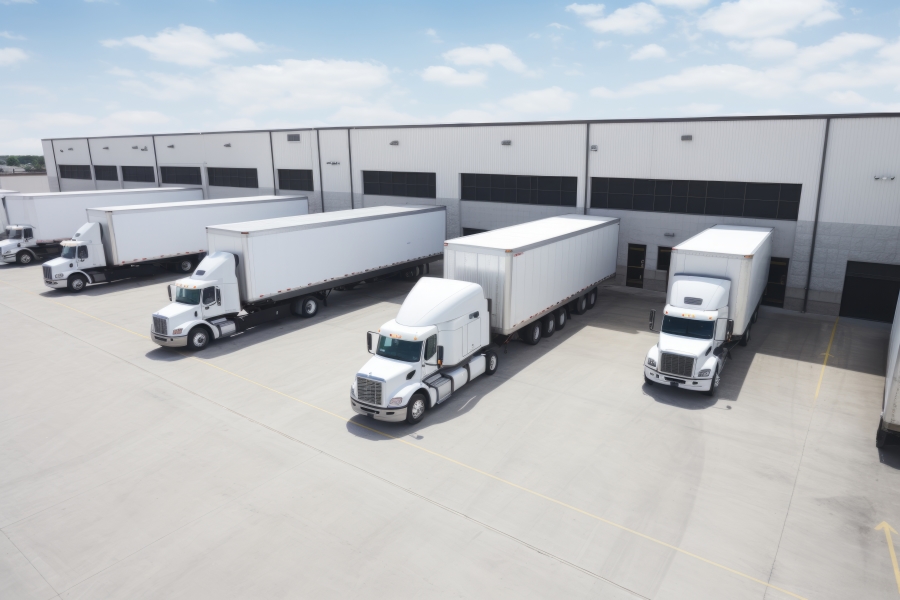
Commercial truck insurance costs are rising, which is adding to an overall increase in the cost of operating a fleet. Although the trends driving commercial truck insurance rate increases are complex, fleet operators do have options for taking control of both risks and costs.
What Does Commercial Trucking Insurance Cost Now?
Commercial truck insurance rates depend on a number of factors, including the size of the fleet and the company’s loss history. Since these factors vary, it’s hard to pinpoint an average trucking insurance cost. However, it is possible to identify commercial auto insurance cost trends. In recent years, the main trend has been increasingly higher rates.
According to the Council of Insurance Brokers & Agents, commercial property and casualty rates have risen for 25 consecutive quarters. During this time, commercial auto insurance rates have also seen some hefty increases. Between 2022 and 2023, quarterly rate increases were between 5.9% and 10.4%.
- Q4 2023: +7.3%
- Q3 2023: +8.8%
- Q2 2023: +10.4%
- Q1 2023: +8.3%
- Q4 2022: +7.3%
- Q3 2022: +7.6%
- Q2 2022: +7.2%
- Q1 2022: +5.9%
Rising Trucking Insurance Rates Are Adding to Operational Costs
If rising commercial trucking insurance costs were the only problem fleet operators had to face, they might be manageable. Unfortunately, fleet operators are also dealing with fuel price fluctuations, rising labor costs, and higher maintenance costs.
The American Transportation Research Institute says 2022 operating costs increased by 21.3% compared to 2021. In 2022, operation costs averaged $2.251 per mile, which is the first time the per-mile cost exceeded $2.000. Higher fuel prices accounted for a sizable portion of this increase. However, operating costs increased by 12% even after subtracting fuel costs.
Rising costs mean trucking companies are having a harder time staying profitable. If risks continue to rise, the problem will become worse, unless fleet operators find a way to control their costs.
Economic and Social Inflation Are Taking Their Toll
You might expect truck insurance costs to increase over time due to the impact of inflation. However, inflation has cooled and auto insurance costs are still rising. Furthermore, since auto insurance costs have risen much faster than inflation, inflation alone cannot fully explain what’s happening.
Social inflation could explain some of the extra costs. Social inflation describes an increase in costs over time – specifically an increase in litigation costs at a rate that’s higher than economic inflation.
Although social inflation may impact any liability line, commercial auto insurance appears to be the most affected. According to the Insurance Information Institute, social inflation is responsible for adding $30 billion in commercial auto liability insurance claims costs between 2012 and 2021.
Oversized jury verdicts are one driving force. These nuclear verdicts raise overall litigation costs and make claims costs more unpredictable. A single claim could put a trucking company out of business. According to Lexology, a Florida jury set a new record in 2021 with a $1 billion verdict in a wrongful death lawsuit against two trucking companies. The verdict included $100 million for pain and suffering and $900 million in punitive damages for negligent hiring and retention.
Combined, economic and social inflation may account for much of the increase in insurance costs. However, there are also other factors at play.
Repairs Have Become More Expensive
While fleet operators are dealing with higher maintenance costs, commercial auto insurance companies are dealing with higher repair costs. These increased repair costs raise the overall cost of claims, resulting in higher insurance prices.
Once again, inflation is an issue driving higher repair costs, but it is not the only factor.
MarketWatch says there’s a widening gap between the number of auto repair workers needed and the number who are currently employed. This labor shortfall is the result of many issues, including an aging workforce that’s entering retirement and the fact people are keeping their old cars for longer, resulting in increased demand for repairs. The labor shortage means repair costs are more expensive.
Advances in technology are also contributing to increasingly expensive repairs. Although sophisticated sensors and automated systems can prevent some collisions, they don’t prevent all collisions. When collisions do occur, these sensors may make repairs more expensive. Griffins Auto Repair explains that previously minor repairs are now complicated due to embedded technology. For example, modern bumpers may now include computer instruments, radars, and sensors that need replacement and rewiring after even a small incident.
Drivers Have Become More Reckless
TransUnion says the death rate for motorists has increased by 22% since the start of the pandemic compared to 2019. The report also found that young drivers are often more accepting of risky behaviors. For example, 30% of Millennials say it’s acceptable to go 20 miles per hour over the speed limit on a major highway or freeway, whereas 38% of Gen Zers says they sometimes, often, or always text while driving.
These figures support data and observations from other sources, indicating an increase in reckless driving during the COVID-19 pandemic. The NHTSA says that, even though Americans drove less during the pandemic, the number of traffic fatalities surged due to an increase in speeding, impaired driving, and failure to wear a seat belt. Early NHTSA estimates for 2023 show that traffic fatalities declined slightly in the first half of the year but remained elevated.
How to Take Control of Your Costs
The first step in taking control of your costs is to take control of your risks.
- Hire safe drivers. Fleet operators can reduce their risks by screening truck drivers.
- Train your drivers. Ongoing training and safety reminders help drivers maintain good habits on the road.
- Foster a culture of safety. If truck drivers feel they have to speed, drive while drowsy, or multitask to meet expectations, they are at risk. Company leaders in the trucking business can help by making safety a priority every day.
- Invest in technology. Telematics systems can spot unsafe driving habits as they happen, whereas cameras can provide evidence if a collision occurs.
By taking control of risks, fleet operators reduce the chance of a claim. However, when auto insurance rates are surging, even low-risk accounts may have higher rates. To see the rewards of good risk management, you need to take more control over your risks.
Some trucking companies lower their commercial truck insurance cost by accepting higher deductibles or self-insured retentions. However, there is another alternative.
For even greater control and potential savings, trucking companies should consider captive insurance structures. Group captive insurance programs are ideal for midsize companies with good risk management practices in place.
ARU’s group captive model is designed to minimize volatility. If you’re serious about risk management and are tired of insurance prices that are subject to the whims of market trends, a member-owned group captive program may be right for you. Learn more about our captive program for the trucking industry.
